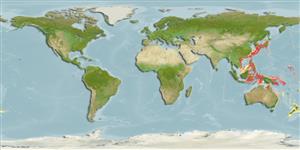>
Ophidiiformes (Cusk eels) >
Bythitidae (Livebearing brotulas)
Etymology: Cataetyx: Greek, kata = down + Greek, etix, stixo, stizo = to prick, to puncture.
More on authors: Smith & Radcliffe.
Environment: milieu / Klimaatzone / Diepte / distribution range
Ecologie
marien bathydemersaal; diepte 100 - 400 m (Ref. 559). Deep-water
Western Pacific: Japan and the Philippines.
Grootte / Gewicht / Leeftijd
Maturiteit: Lm ? range ? - ? cm
Max length : 13.0 cm SL mannelijk / geslacht onbekend; (Ref. 559)
Dorsale stekels (totaal) : 0; Dorsale zachte stralen (totaal) : 75 - 81; Anale stekels: 0; Anale zachte stralen: 49 - 56. Head with scales. Pseudobranches with 2 small filaments. Three gill rakers developed on 1st arch. Attains 13 cm SL.
Body shape (shape guide): elongated; Cross section: oval.
Rare species (Ref. 34024). Taken in bottom trawls (Ref. 34024).
Levenscyclus en paargedrag
Maturiteit | Voortplanting | Paaien | Eieren | Fecunditeit | Larven
Nielsen, J.G., D.M. Cohen, D.F. Markle and C.R. Robins, 1999. Ophidiiform fishes of the world (Order Ophidiiformes). An annotated and illustrated catalogue of pearlfishes, cusk-eels, brotulas and other ophidiiform fishes known to date. FAO Fish. Synop. 125(18):178p. Rome: FAO. (Ref. 34024)
Status op de Rode Lijst van het IUCN (Ref. 130435: Version 2025-1)
Gevaar voor de mens
Harmless
Gebruik door de mens
Visserij: van geen belang
Tools
Speciale rapporten
Download XML
Internetbronnen
Estimates based on models
Preferred temperature (Ref.
123201): 12.4 - 21.7, mean 16.4 °C (based on 110 cells).
Fylogenetische diversiteitsindex (Ref.
82804): PD
50 = 0.5005 [Uniqueness, from 0.5 = low to 2.0 = high].
Bayesian length-weight: a=0.00447 (0.00172 - 0.01163), b=3.10 (2.87 - 3.33), in cm total length, based on LWR estimates for this (Sub)family-body shape (Ref.
93245).
Trofisch niveau (Ref.
69278): 3.4 ±0.5 se; based on size and trophs of closest relatives
Weerstandsvermogen (Ref.
120179): laag, minimale populatieverdubbelingstijd 4,5-14 jaar (Assuming Fec < 100).
Fishing Vulnerability (Ref.
59153): Low vulnerability (10 of 100).
🛈
